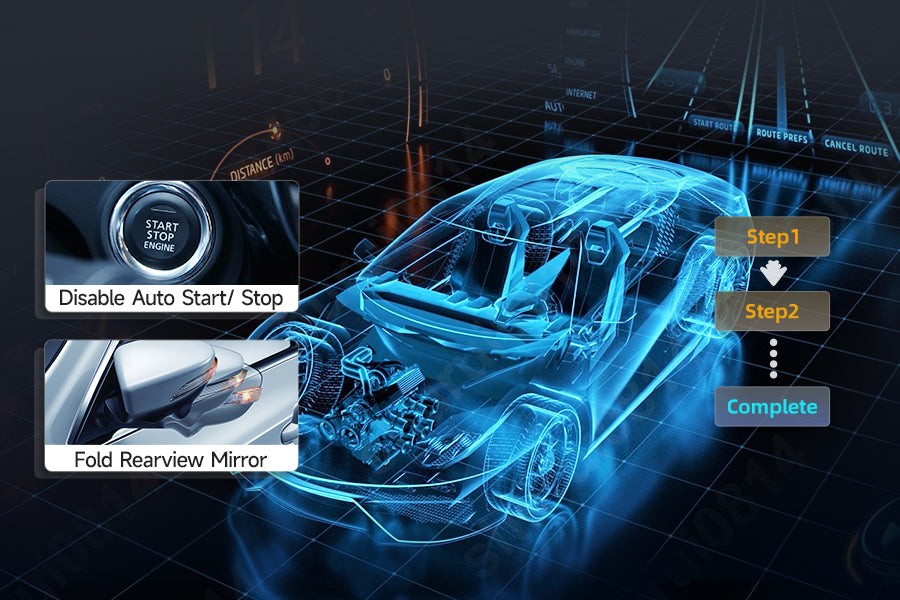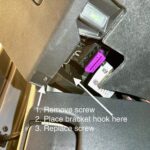Modern vehicles are equipped with sophisticated On-Board Diagnostics (OBD2) systems that continuously monitor your car’s performance. When an issue arises, these systems generate diagnostic trouble codes, often indicated by the dreaded check engine light. Typically, you would use an OBD2 scanner to read and clear these codes. However, what do you do if you don’t have a scanner handy? This guide will explore several effective methods to clear OBD2 codes without relying on a scanner, empowering you to manage minor issues and understand your vehicle better.
Understanding Why You Might Need to Clear OBD2 Codes
Before we delve into the methods, it’s crucial to understand why clearing OBD2 codes might be necessary. While it’s essential to address the root cause of any error codes, there are legitimate reasons for wanting to clear them:
- Check Engine Light Reset: Once you’ve addressed the underlying issue causing the error code, the check engine light may remain illuminated. Clearing the codes turns off the light, confirming the system recognizes the problem is resolved. This helps avoid confusion from persistent warnings about issues that are no longer present.
- Emissions Test Compliance: Many regions require vehicles to pass emissions tests. A lit check engine light, even for a resolved issue, can lead to failing the test. Clearing codes after repairs ensures your car’s system is ready for inspection and meets emission standards.
- Temporary Diagnostic Step: In some situations, clearing codes can be a useful step in diagnosing intermittent problems. By clearing the codes and observing if and when they reappear, you can gain valuable information about the nature and frequency of the issue. This can be particularly helpful for issues that don’t constantly trigger the check engine light.
It’s important to remember that clearing OBD2 codes is not a substitute for proper diagnosis and repair. If the check engine light returns shortly after clearing the codes, it indicates a persistent problem that needs professional attention.
Effective Methods to Clear OBD2 Codes Without a Scanner
While an OBD2 scanner offers the most direct and reliable way to clear codes, several alternative methods can achieve the same result, especially for minor or resolved issues. Here are some of the most common and effective techniques:
1. The Battery Disconnection Method: A Simple Reset
Disconnecting your car’s battery is a straightforward way to reset the vehicle’s computer, which in turn can clear OBD2 codes. This method essentially cuts power to the Engine Control Unit (ECU) and other modules, forcing them to reset upon reconnection. Here’s a step-by-step guide:
- Ensure Ignition is Off: Turn off your car completely and remove the keys from the ignition. This is crucial for safety and prevents electrical damage during the process.
- Locate the Car Battery: Open your vehicle’s hood and find the battery. It’s typically located in the engine bay, but in some models, it might be under the rear seat or in the trunk.
- Disconnect the Negative Terminal: Using a wrench of the correct size, loosen the nut on the negative battery terminal (usually marked with a “-” sign and often black). Carefully detach the negative cable from the terminal. Ensure the cable is moved away from the terminal to prevent accidental contact.
- Wait for Sufficient Time: Allow the car to sit for at least 15 minutes. This waiting period ensures that any residual electrical charge dissipates and the ECU memory is fully cleared. Some mechanics recommend pressing the brake pedal a few times during this period to expedite the discharge of any stored power.
- Reconnect the Negative Terminal: After waiting, carefully reconnect the negative battery cable to the terminal and tighten the nut securely with the wrench. Make sure the connection is firm.
- Start Your Vehicle: Turn on your car’s ignition and check if the check engine light has turned off. If it has, the OBD2 codes have likely been cleared.
Important Note: Disconnecting the battery will reset various vehicle systems, including your radio presets, clock, and potentially some driver preference settings. You may need to reset these after reconnecting the battery. This method is generally safe but should be done with caution, especially in modern cars with complex electronics.
2. Fuse Box Method: Targeting the ECU Power Supply
Another method involves removing the fuse that specifically powers the car’s Engine Control Unit (ECU). This is a more targeted approach than battery disconnection, as it focuses solely on resetting the ECU. Here’s how to do it:
- Turn Off the Ignition: Ensure your car is completely off before starting.
- Locate the Fuse Box: Consult your vehicle’s owner’s manual to find the location of the fuse box. Modern cars often have multiple fuse boxes, typically located under the dashboard, in the engine compartment, or sometimes in the trunk.
- Identify the ECU Fuse: Refer to the fuse box diagram, usually printed on the inside of the fuse box cover or in your owner’s manual. Locate the fuse labeled “ECU,” “PCM,” “Engine Control,” or similar terminology related to the engine control unit.
- Remove the ECU Fuse: Use a fuse puller (often included in the fuse box) or needle-nose pliers to carefully remove the identified fuse. Be gentle to avoid damaging the fuse or the fuse box terminals.
- Wait for Code Reset: Allow the car to remain without the fuse for about 15 minutes to ensure the ECU’s memory is cleared.
- Reinsert the Fuse: After waiting, firmly reinsert the ECU fuse back into its designated slot in the fuse box. Ensure it’s properly seated.
- Start Your Vehicle and Check: Turn on the ignition and check if the check engine light has been reset.
This method is generally considered safe and less disruptive than battery disconnection, as it primarily targets the ECU reset without affecting other vehicle systems. However, always consult your car’s manual for specific fuse locations and procedures.
3. The Drive Cycle Method: A Natural System Check
The drive cycle method is a more involved approach that relies on driving your car through a specific sequence of conditions that prompt the OBD2 system to run comprehensive self-tests. If no faults are detected during these tests, the system may automatically clear certain types of OBD2 codes, particularly those related to emissions. Here is a general drive cycle procedure:
- Cold Start Procedure: Start your car after it has been sitting for at least eight hours to ensure the engine and catalytic converter are completely cold.
- Idle Phase: Let the engine idle in park (or neutral for manual transmissions) for approximately two to three minutes. Do not touch the accelerator pedal.
- Acceleration Phase: Accelerate smoothly and gradually to a speed of 45 to 55 mph (72 to 88 km/h).
- Maintain Steady Speed: Maintain a constant speed between 45 and 55 mph for about 15 to 20 minutes. Avoid sudden acceleration or braking.
- Deceleration and Stop-and-Go: Safely decelerate and then drive in stop-and-go traffic conditions for another 5 to 10 minutes, including several stops and starts. This simulates city driving.
- Idle Again: Idle the engine again for two to three minutes in park or neutral.
- Complete Drive Cycle: Turn off the ignition and allow the vehicle to sit for a few minutes.
It’s important to note that a drive cycle may need to be repeated several times over a few days to fully clear codes, and it is not guaranteed to work for all types of codes. Specific drive cycle procedures can vary slightly depending on the vehicle manufacturer and model. Consult your car’s repair manual or online resources specific to your make and model for the most accurate drive cycle instructions.
4. Utilizing a Low-Cost OBD2 Bluetooth Adapter and Smartphone App
While this method technically involves an OBD2 “adapter,” it’s a significantly more affordable and accessible alternative to a dedicated scanner. Bluetooth OBD2 adapters are inexpensive and, when paired with a smartphone app, can provide basic OBD2 functionality, including code clearing.
- Purchase a Bluetooth OBD2 Adapter: These adapters are readily available online and at auto parts stores for a relatively low cost. Ensure it’s compatible with your smartphone’s operating system (iOS or Android).
- Locate the OBD2 Port: Find the OBD2 port in your vehicle. It’s typically located under the dashboard on the driver’s side, near the steering column.
- Plug in the Adapter: Plug the Bluetooth OBD2 adapter securely into the OBD2 port.
- Download a Compatible App: Download an OBD2 app on your smartphone. Popular options include Torque Pro (Android), OBD Fusion (iOS and Android), and Car Scanner ELM OBD2 (iOS and Android). Many apps offer free and paid versions with varying features.
- Pair Adapter and Smartphone: Follow the app’s instructions to pair your smartphone with the Bluetooth OBD2 adapter. This usually involves enabling Bluetooth on your phone and selecting the adapter from the list of available devices within the app.
- Clear OBD2 Codes with the App: Once connected, navigate the app’s menu to find the “fault codes,” “error codes,” or “trouble codes” section. The app should display any stored OBD2 codes and provide an option to clear them. Follow the app’s prompts to clear the codes.
This method provides a balance of affordability and functionality, offering a way to clear codes and even read basic diagnostic information without investing in a full-fledged scanner.
Conclusion: Informed Code Clearing for Vehicle Maintenance
While a dedicated OBD2 scanner remains the most convenient and feature-rich tool for managing OBD2 codes, these scanner-free methods offer practical alternatives when you need to clear codes without immediate access to a scanner. Whether you choose to disconnect the battery, remove a fuse, perform a drive cycle, or use a budget-friendly Bluetooth adapter and app, understanding these techniques empowers you to address minor issues and maintain your vehicle more effectively.
Always remember that clearing OBD2 codes should be done responsibly and with an understanding of your vehicle’s condition. If the check engine light persists or returns quickly, it’s crucial to seek professional diagnosis and repair to address the underlying problem and ensure your vehicle’s long-term health and performance.
FAQs
Can I reset my car’s check engine light without a scanner?
Yes, as detailed above, methods like battery disconnection, fuse removal, drive cycles, and OBD2 apps with Bluetooth adapters can effectively reset the check engine light.
Will resetting codes without a scanner harm my car?
Generally, no. These methods are designed to reset the car’s computer system, similar to how a scanner clears codes. However, always follow instructions carefully and consult your vehicle’s manual if you have concerns.
How long does it take to reset car codes without a scanner?
The battery disconnection and fuse removal methods typically take about 15-20 minutes, including waiting time. Drive cycles can take longer and may require multiple attempts over several days. Using an OBD2 app is usually the quickest, taking only a few minutes once connected.

